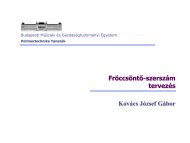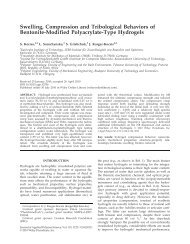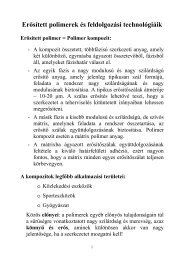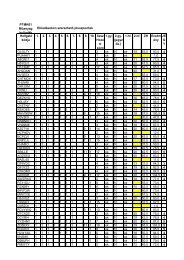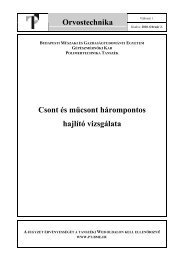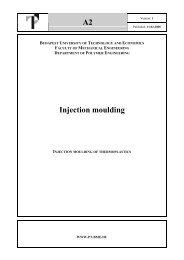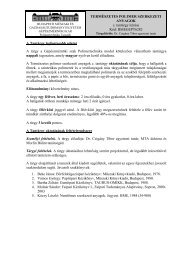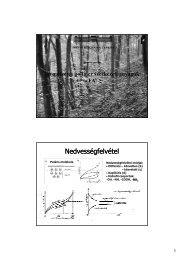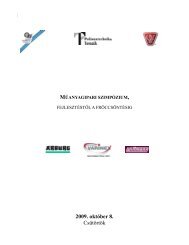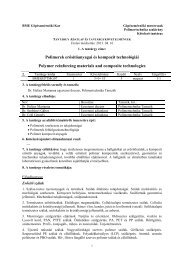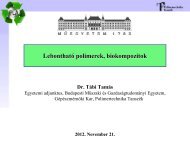Flexural creep of all-polypropylene composites: Model analysis
Flexural creep of all-polypropylene composites: Model analysis
Flexural creep of all-polypropylene composites: Model analysis
Create successful ePaper yourself
Turn your PDF publications into a flip-book with our unique Google optimized e-Paper software.
<strong>Flexural</strong> Creep <strong>of</strong> All-Polypropylene Composites:<strong>Model</strong> AnalysisK. Banik, J. Karger-Kocsis, T. AbrahamMaterials Science, Institute for Composite Materials (Institut für Verbundwerkst<strong>of</strong>fe GmbH),Technical University <strong>of</strong> Kaiserslautern, D-67663 Kaiserslautern, GermanyIn this article, simple viscoelastic and empirical modelsare presented to predict and analyze the flexural <strong>creep</strong>behavior <strong>of</strong> <strong>all</strong>-poly(propylene) (<strong>all</strong>-PP) <strong>composites</strong>.Results <strong>of</strong> the successful application <strong>of</strong> these modelsto the actual <strong>creep</strong> behavior <strong>of</strong> unidirectional (UD) andcross-ply (CP) <strong>all</strong>-PP <strong>composites</strong> tested by short-termflexural <strong>creep</strong> measurements over a temperature range<strong>of</strong> 20–808C are presented. Analysis <strong>of</strong> the momentary<strong>creep</strong> behavior <strong>of</strong> <strong>all</strong>-PP <strong>composites</strong> with different tapelay-ups are made to understand their deformationmechanism. Further to the main theme <strong>of</strong> the article,an interesting discrepancy while predicting the longterm<strong>creep</strong> behavior <strong>of</strong> these <strong>composites</strong> based on thetime-temperature superposition (TTS) principle andFindley power law model is visualized which has alsobeen illustrated here. POLYM. ENG. SCI., 48:941–948, 2008.ª 2008 Society <strong>of</strong> Plastics EngineersINTRODUCTIONPoly(propylene) (PP) is apparently the major polymericconstruction material <strong>of</strong> future in view <strong>of</strong> its impressiveconsumption in the past few decades. Fibers are frequentlyused for improving the strength and stiffness <strong>of</strong>this material. Several studies were reported concerningthe reinforcement <strong>of</strong> PP using different types <strong>of</strong> fibers toachieve improvement in the thermal, structural, and mechanicalproperties. Among the various fibers, which havebeen used for PP <strong>composites</strong>, glass fibers are the mostcommon. Although excellent mechanical properties havebeen achieved in this way, but life cycle assessment doesnot yield favorable results for PP <strong>composites</strong> when theyare tradition<strong>all</strong>y reinforced with glass, carbon, aramidfibers, or fabrics. This is mostly because <strong>of</strong> the energyintensiveproduction <strong>of</strong> the above reinforcing fibers andlimited recyclability <strong>of</strong> the corresponding <strong>composites</strong>.This laid to the alternative search for recycling friendlyCorrespondence to: K. Banik; e-mail: kaushik.banik@ge.comBanik is currently at GE India Technology Centre, Bangalore, India.Contract grant sponsor: German Research Foundation; contract grantnumber: DFG Ka 1202/17.DOI 10.1002/pen.21041Published online in Wiley InterScience (www.interscience.wiley.com).VC 2008 Society <strong>of</strong> Plastics Engineersnovel homo<strong>composites</strong>. Self-reinforced PP homo<strong>composites</strong>represent an effective alternative to the traditionalfiber reinforced <strong>composites</strong> where the matrix and the reinforcementare from the same polymer, thereby supportingthe ease <strong>of</strong> recyclability. Thus <strong>all</strong>-PP <strong>composites</strong> f<strong>all</strong>under a new class <strong>of</strong> material that shows great potential.The group <strong>of</strong> Peijs [1–6] has recently developed a promisingroute <strong>of</strong> manufacturing <strong>all</strong>-PP <strong>composites</strong> based onthe consolidation <strong>of</strong> the coextruded fibers/tapes. Thenewly developed <strong>all</strong>-PP <strong>composites</strong> make use <strong>of</strong> highmodulus PP homopolymer tapes, which are coextrudedwith a thin coating <strong>of</strong> a PP copolymer. The <strong>all</strong>-PP <strong>composites</strong>thus possess a high volume fraction (90%) <strong>of</strong>highly oriented PP reinforcement fraction and 10% volumefraction <strong>of</strong> copolymer layer which acts as a matrixwhen hot consolidated. By this method a processing temperaturewindow [308C can be achieved [1]. The commercialbreakthrough <strong>of</strong> this material was achieved(PURE 1 ).The behavior <strong>of</strong> <strong>all</strong>-PP <strong>composites</strong> in a monotonic state<strong>of</strong> deformation is an important issue for load-bearingapplications. Gener<strong>all</strong>y polymers exhibit elastic action onloading (if loading is rapid enough), and then a slow andcontinuous increase <strong>of</strong> strain at a decreasing rate can beobserved. When the stress is removed a continuouslydecreasing strain follows an initial elastic recovery. Theyare significantly influenced by the rate <strong>of</strong> straining orstressing. For example, the longer the time to reach thefinal value <strong>of</strong> stress at a constant rate <strong>of</strong> stressing, thelarger is the corresponding strain [7]. Polymers are thereforeregarded as viscoelastic materials. Since time is avery important factor in their behavior, they are alsoc<strong>all</strong>ed time-dependent materials. Developments in thetechnology, such as the production <strong>of</strong> gas turbines, jetengines, nuclear power plants, and space crafts, haveplaced severe demands on high-temperature performance<strong>of</strong> materials, including plastics. Consequently, the timedependentbehavior <strong>of</strong> materials has become <strong>of</strong> greatimportance. This time-dependent behavior <strong>of</strong> polymericmaterials under a quasi-static state has been very <strong>of</strong>tenstudied by <strong>creep</strong>. Previous research works on <strong>all</strong>-PP <strong>composites</strong>has shown so far that the <strong>creep</strong> behavior PP/PPPOLYMER ENGINEERING AND SCIENCE—-2008
<strong>composites</strong> depends strongly on stress, temperature, voidcontent, fiber loading, and fiber dimensions [8–11]. One<strong>of</strong> the greatest constraints in studying the <strong>creep</strong> behavioris the relatively long time required for performing a test.Hence, time-temperature superposition (TTS) methodsthat are able to predict the long-term data have gainedconsiderable attention [12–15]. Also many viscoelasticand empirical models have been proposed to predict thelong-term <strong>creep</strong> behavior <strong>of</strong> polymers and their <strong>composites</strong>[7, 9].In this article, the <strong>creep</strong> behavior <strong>of</strong> <strong>all</strong>-PP <strong>composites</strong>produced by different tape lay-ups is analyzed using simpleviscoelastic and empirical models to understand theirdeformation mechanism. Also, it has been illustratedusing the Findley equation that the applicability <strong>of</strong> themodel to predict the long-term <strong>creep</strong> depends, apart fromthe test temperature, on the material property, viz. cryst<strong>all</strong>initythat changes during the course <strong>of</strong> <strong>creep</strong> when thethermal or mechanical conditioning <strong>of</strong> the test specimensis ignored.CREEP AND CREEP MODELSCreep is a slow, progressive deformation <strong>of</strong> a materialunder constant stress. When a plastic material is subjectedto a constant load, it deforms continuously with time.This time-dependent behavior <strong>of</strong> materials, referred to asviscoelasticity, is also an important characteristic <strong>of</strong> reinforcedplastics. In general, for a constant stress, r, the<strong>creep</strong> compliance J(t) can be written as the ratio <strong>of</strong> thestrain (e) to stress at a certain time (t) as follows:JT; ð tÞ ¼ eðT;tÞ: (1)sBesides experimental observation, highly developed <strong>creep</strong>modeling in traditional <strong>composites</strong> can also be applied tothe polymer homo<strong>composites</strong> to develop comprehensiveunderstanding <strong>of</strong> the <strong>creep</strong> deformation. In the past halfcentury, numerous <strong>creep</strong> models have been proposed andapplied to describe the <strong>creep</strong> behavior <strong>of</strong> viscoelasticmaterials [7, 12, 13, 16–21]. Various materials <strong>of</strong> thesame geometry may respond differently under identicalexternal effects. Such differences in response are <strong>of</strong>tenattributed to the inherent constitution <strong>of</strong> the materials.Consequently, the response behavior <strong>of</strong> a particular material,or a class <strong>of</strong> materials, is described mathematic<strong>all</strong>yby the so-c<strong>all</strong>ed constitutive relations [22]. Thus, the<strong>creep</strong> behavior <strong>of</strong> an isotropic linear viscoelastic systemcan be represented byZeðÞ¼s t 0 f ðÞexp t ð1t=tÞdt; (2)0where e(t) is the <strong>creep</strong> strain, t is the time, s 0 is theapplied stress, t is the retardation time, and f(t) is the distribution<strong>of</strong> the retardation time. Although it is assumedthat such an expression should represent an experimental<strong>creep</strong>, it is actu<strong>all</strong>y not so because accurate informationabout f(t) is rather elusive [23]. Several models weredeveloped using the constitutive relation to explain the<strong>creep</strong> behavior <strong>of</strong> polymeric materials using very simpleelastic or viscous system and a complex combination <strong>of</strong>both. The basic constitutive equation for <strong>creep</strong> models hasthe following qualitative form:e ¼ e 0 þ e c ; (3)where e is the total strain at some time, t, after a stressapplication, e c , time-dependent <strong>creep</strong> component <strong>of</strong> strainat t, and e 0 is the instantaneous strain after stress application.The instantaneous strain component (e 0 ) is elasticand the <strong>creep</strong> component, e c , is a simple arithmetic function<strong>of</strong> time (linear, logarithm, exponential, power law),either alone or in combination, to define the basic behavior<strong>of</strong> this aspect. All linear viscoelastic models are madeup <strong>of</strong> linear springs and linear dashpot. Inertia effects areneglected in such models [7]. Also, there have been severalattempts to develop constitutive models to describetheir nonlinear <strong>creep</strong> behavior. The most widely usednonlinear viscoelastic models are the Schapery model andits modifications, which are based on irreversible thermodynamicsprinciples and have shown to accuratelydescribe <strong>creep</strong> performance [24, 25]. More recently, Deanand Broughton [26] modeled the nonlinear <strong>creep</strong> behavior<strong>of</strong> <strong>polypropylene</strong> under uniaxial tension using a stretchedexponential function with four parameters. Nonlinearbehavior arises because one <strong>of</strong> the parameters, related toa mean retardation time for the relaxation process responsiblefor <strong>creep</strong>, is dependent on stress. There is no doubtthat nonlinear viscoelastic behavior predominates over amajor portion <strong>of</strong> the whole response interval <strong>of</strong> most polymericmaterials and plays the key role in most applications[16, 17]. On the other hand, if the material is testedin the linear viscoelastic range, its <strong>creep</strong> behavior can berepresented by simple rheological models. The Burgermodel, which is a combination <strong>of</strong> elastic and viscous elements,has been reported to give a satisfactory representation<strong>of</strong> the <strong>creep</strong> compliance [7, 9, 27].Burger model is a series <strong>of</strong> combinations <strong>of</strong> Maxwelland Kelvin-Voigt models [7, 9, 27]. Figure 1 shows ascheme <strong>of</strong> four-element Burger model. According to thismodel, the total strain is given by the general equatione ¼ e 1 þ e 2 þ e 3 ; (4)e ¼ s þ s ð1 expðtE 2 =ZE 1 E 2 ÞÞþ ts ; (5)2 Z 1where e 1 and e 2 are the elastic and viscous strain representedby the Maxwell model and e 3 is the viscoelasticstrain represented by Kelvin-Voigt model, E 1 and E 2 representthe moduli <strong>of</strong> the Maxwell and the Kelvin spring,Z 1 and Z 2 represent the viscosity <strong>of</strong> the Maxwell and942 POLYMER ENGINEERING AND SCIENCE—-2008 DOI 10.1002/pen
The long-term <strong>creep</strong> behavior may be predicted fromshort-term <strong>creep</strong> data by applying the time-temperaturesuperposition (TTS) principle. The premise <strong>of</strong> TTS is thattemperature accelerates the <strong>creep</strong> deformation kinetics.Hence <strong>creep</strong> curves at different temperatures may beshifted along the logarithmic time axis until they superimposeto form <strong>creep</strong> master curve extending to much longertimes than the short term data. The validity <strong>of</strong> TTSmust be established by long-term tests but is nonethelessuseful for obtaining a general description <strong>of</strong> the material’slong-term behavior [29, 30].FIG. 1.Schematic representation <strong>of</strong> the four-element Burger model.Kelvin dashpot respectively, s is the applied stress andt is the <strong>creep</strong> time.Besides the constitutive models, empirical or mathematicaldescriptions have also been widely studied [7]due to their simple expression and satisfactory simulationor prediction capability. Among these, the Findley powerlaw model is commonly accepted. The constitutive equationproposed by Findley is simplified in the followingform [7, 28]:e F ¼ e 0 þ e c t n : (6)Here n is a dimensionless material parameter, e 0 is the instantaneousor time-independent strain (functions <strong>of</strong> stressand environment variables including temperature, moisture,etc.), and e c is the time-dependent term. The symbolt may be taken to represent a dimensionless time ratiot/t 0 , where t 0 is the unit time. e 0 , e c , and n are <strong>creep</strong>parameters and each can be assigned a numerical valueby experiment<strong>all</strong>y measuring the instantaneous and timedependentcompliance <strong>of</strong> a viscoelastic material and thencalculating the values from Eq. 6. Because <strong>of</strong> the oversimplification<strong>of</strong> this model (it does not take into considerationthe changes in the shape <strong>of</strong> the material), thevalues calculated from the above equation cannot beunivers<strong>all</strong>y applied. The shape <strong>of</strong> a material depends onmolecular mobility and is a function <strong>of</strong> the microstructureand molecular alignments during the processing <strong>of</strong> materialsand the shape from sample to sample can be influencedby other external factors such as moisture content,humidity, and temperature. Since <strong>all</strong>-PP <strong>composites</strong> likeother viscoelastic materials are very much influenced bythe factors as detailed above, the parameters obtainableby the power law model can only give an approximation<strong>of</strong> the real behavior. Nevertheless, it is expected that thismodel can be used as a first hand tool to predict the longtermdeformation behavior <strong>of</strong> <strong>all</strong>-PP <strong>composites</strong>.EXPERIMENTALIn this study, commerci<strong>all</strong>y available <strong>all</strong>-PP (PURE 1 )coextruded tapes, obtained from Lankhorst-Indutech B.V.(Sneek, The Netherlands), was used to make the unidirectional(UD) and cross-ply (CP) laminates. The PP tapeshave a skin-core-skin (A-B-A) morphology with PPhomopolymer as the core and a random PP copolymer asthe skin layer. The other characteristics <strong>of</strong> these coextrudedtapes are available in the literatures published earlier[31, 32].The manufacture <strong>of</strong> <strong>all</strong>-PP <strong>composites</strong> involved a twostageprocess—winding <strong>of</strong> the PP tapes, [both unidirectional(08) and cross-ply (08/908)], and consolidation <strong>of</strong>the fabric plies at a suitable temperature and pressure inan autoclave. For winding the tapes, a filament windingtechnique was adopted. A detailed description <strong>of</strong> the compositemanufacture is available in the references [31, 32].<strong>Flexural</strong> <strong>creep</strong> tests were performed using three-pointbending mode at temperatures ranging from 208C to808C, in the same DMA Q800 apparatus. Isothermal testswere run on the specimens by increasing the temperaturestepwise by 108C. Before the <strong>creep</strong> measurement, thespecimens were equilibrated for 5 min at each temperatureand then the flexural <strong>creep</strong> behavior was tested for30 min. All the tests were performed under a constantload <strong>of</strong> 10 MPa. Test specimens <strong>of</strong> dimensions 60 3 153 1.8 mm 3 (length 3 width 3 thickness) were employedfor <strong>creep</strong> studies and the average <strong>of</strong> three statistic<strong>all</strong>yrelevant <strong>creep</strong> data has been reported for each kind <strong>of</strong>specimen.To determine the cryst<strong>all</strong>inity <strong>of</strong> the <strong>all</strong>-PP <strong>composites</strong>,differential scanning calorimetric (DSC) investigationswere performed before and after the <strong>creep</strong> tests using aMettler-Toledo DSC 821 instrument (Greifensee, Switzerland).The cryst<strong>all</strong>inity contents <strong>of</strong> the <strong>composites</strong> werecharacterized from the enthalpy <strong>of</strong> fusion associated inthe first heating run. Heating scans were performed from258C to 2008C at a heating rate <strong>of</strong> 108C/min with nitrogenblanketing inside the sample chamber. An average <strong>of</strong>three specimens was taken for each <strong>of</strong> the specimens.The cryst<strong>all</strong>inity was then determined by taking the ratio<strong>of</strong> the enthalpy <strong>of</strong> fusion <strong>of</strong> the <strong>all</strong>-PP composite to theenthalpy <strong>of</strong> fusion <strong>of</strong> 100% cryst<strong>all</strong>ine PP taken as207.1 J/g [33].DOI 10.1002/pen POLYMER ENGINEERING AND SCIENCE—-2008 943
Isochronous strain-stress plots for CP <strong>all</strong>-PP composite speci-FIG. 2.mens.RESULTS AND DISCUSSIONDetermination <strong>of</strong> Linear Viscoelastic RegionTo ensure working in the linear viscoelastic region,isochronous experiments were conducted for the <strong>all</strong>-PP<strong>composites</strong>. Short-term <strong>creep</strong> experiments lasting for30 min was performed for a series <strong>of</strong> stresses increasedstepwise from 2 MPa to 10 MPa. From the series <strong>of</strong>applied stresses, strain–stress plots were constructed. Figure2 represents the strain–stress results for the CP <strong>all</strong>-PPcomposite specimens conducted at room temperature(23 6 1)8C. From <strong>analysis</strong> <strong>of</strong> the isochronous tests forthe CP <strong>all</strong>-PP <strong>composites</strong> (the specimens showing thelargest <strong>creep</strong> deformation), a stress <strong>of</strong> 10 MPa wasselected for testing <strong>all</strong> the samples.Experimental Creep ResultsThe experimental data for the <strong>creep</strong> strain versus timeat different temperatures ranging from 208C to808C areshown in Fig. 3 for <strong>all</strong>-PP <strong>composites</strong> with UD and CPlay-ups. As expected, variation <strong>of</strong> the test temperatureshows a remarkable effect on the <strong>creep</strong> behavior <strong>of</strong> the<strong>all</strong>-PP <strong>composites</strong> with enhanced <strong>creep</strong> tendency as thetemperature is increased. This effect can be recognized asthe effect <strong>of</strong> temperature on the mobility <strong>of</strong> the macromolecularchains. With the increase in temperature, mobility<strong>of</strong> the macromolecules increases which leads to higherdeformation <strong>of</strong> the <strong>composites</strong>. It is also clear from theresults that the CP laminates show higher <strong>creep</strong> strainthan the UD ones at <strong>all</strong> the temperatures indicating higherresistance to <strong>creep</strong> in the case <strong>of</strong> later. This could beexplained from the difference in the composite morphology,namely cryst<strong>all</strong>inity and void content as well as thereinforcement architecture [32]. In the case <strong>of</strong> UD <strong>composites</strong>,in addition to the lower amount <strong>of</strong> voids as well ashigher percentage <strong>of</strong> cryst<strong>all</strong>inity, higher volume fraction<strong>of</strong> the tapes in the longitudinal direction remarkablyincreased the strength and stiffness <strong>of</strong> the <strong>all</strong>-PP <strong>composites</strong>and thereby a reduction in <strong>creep</strong> strain. Figure 3 alsoindicates that the <strong>creep</strong> rate increases with the increase intemperature as the slope <strong>of</strong> the <strong>creep</strong> curves tends toincrease with temperature.From Fig. 3, it appears that the shapes <strong>of</strong> the various<strong>creep</strong> curves are amenable to the well-known reductionscheme <strong>of</strong> time–temperature superposition. Coincidence<strong>of</strong> the data is good and the master curves obtained byTTS principle (Fig. 4) show higher <strong>creep</strong> resistance forUD <strong>all</strong>-PP <strong>composites</strong> as anticipated from the short-term<strong>creep</strong> data. Gener<strong>all</strong>y, the master curves are importantsince the polymer’s behavior can be traced over muchgreater periods <strong>of</strong> time than those determined experiment<strong>all</strong>y.The shift factors, a T , necessary to generate the mastercurves was obtained directly from the experimental<strong>creep</strong> curves plotted against time by measuring theamount <strong>of</strong> shift along the time scale necessary to superimposethe curves on the reference. The reference temperaturewas chosen as 308C for both the composite types.The log a T values thus obtained by shifting the <strong>creep</strong>curves are listed in Table 1. It shows that log a T decreasesFIG. 3. Creep response <strong>of</strong> UD and CP <strong>all</strong>-PP <strong>composites</strong> at different temperatures (n 208C, l 308C,~ 408C, ! 508C, ^ 608C, 3 708C, " 808C); solid lines represent Burger fit.944 POLYMER ENGINEERING AND SCIENCE—-2008 DOI 10.1002/pen
TABLE 2.Parameters obtained from the Burger model.SpecimenTemperature(8C)E 1(MPa)E 2(MPa)g 1(GPa-s)g 2(GPa-s)FIG. 4. Creep strain master curves generated for <strong>all</strong>-PP <strong>composites</strong>with unidirectional (UD) and cross-ply (CP) lay-ups; T ref is the referencetemperature.with increasing temperature. The negative sign indicates ashift to the right <strong>of</strong> the <strong>creep</strong> curves, that is, toward thereference at lower temperature. A higher shift value thusindicates a larger shifting <strong>of</strong> the <strong>creep</strong> curve to the referencecurve. The shifting scheme indicates that as temperatureincreases, molecular relaxation accumulate at a constantrate and that the underlying mechanism <strong>of</strong> <strong>creep</strong>remains unchanged.Creep <strong>Model</strong>ing AnalysisSimulated <strong>creep</strong> curves using the Burger model arealso shown in Fig. 1 with the solid lines. It can be seenthat they show a satisfactory agreement with the experimentaldata at each temperature. The first instantaneousdeformation arises from the spring or the elastic element(E 1 ) and later time-dependent deformation comes fromthe par<strong>all</strong>el spring and dashpot (g 2 ) and from the viscousdashpot flow (g 1 ). The model parameters obtained for the<strong>all</strong>-PP <strong>composites</strong> produced by unidirectional and crossplylay-ups are shown in Table 2. According to theseresults, viscosity decreased with increase in the <strong>creep</strong> testtemperature and higher flow occurred in the dashpot andpermanent deformation increased. In the viscous part, g 2TABLE 1.Temperature (8C)Shift factor (log a T ) for the UD and CP <strong>all</strong>-PP <strong>composites</strong>.UDlog a T20 1.16 1.06730 0 040 21.215 21.14850 22.304 21.95160 23.151 22.51270 23.786 22.99880 24.426 23.501CPUD 20 1.22 6.37 12.11 0.4230 1.10 4.30 10.00 0.2540 0.94 2.67 5.00 0.1550 0.78 1.74 2.50 0.1060 0.66 1.40 2.00 0.0770 0.55 1.20 1.67 0.0780 0.48 1.09 1.11 0.06CP 20 0.49 2.39 3.33 0.1530 0.44 1.57 2.00 0.1040 0.38 0.91 1.25 0.0650 0.33 0.68 1.11 0.0360 0.29 0.63 1.10 0.0270 0.25 0.62 1.07 0.0280 0.23 0.62 1.00 0.02tends to decrease with the increase in the temperatureconfirming that the rise in temperature increases the mobility<strong>of</strong> the polymer chains. The modulus (E 1 ) <strong>of</strong> theMaxwell spring showed a decreasing function with temperature,which can be attributed to the s<strong>of</strong>tening <strong>of</strong> thematerial at elevated temperature and the stiffness thusdecreased with diminished instantaneous modulus. Thisindicates that the plastic deformation becomes severe atelevated temperature. The retardant elasticity (E 2 ) and viscosity(g 2 ) showed a similar dependency on temperature,thus decreasing with increasing temperature. It could bealternatively stated that the deformation <strong>of</strong> the Kelvin-Voigt unit increased with increasing temperature. InterestinglyTable 2 also shows that the variation in the tapelay-up has a significant effect on the viscous and elasticcomponents <strong>of</strong> the Burger model as they were found tobe higher for UD than for the CP composite specimens.This arises from the difference in the microstructures andthe tape lay-up. It strongly suggests that the variationin the reinforcement architecture has a significant effect onthe viscoelastic properties. Because <strong>of</strong> the higher viscousflow and lower elastic modulus, CP composite specimensdeform more than that <strong>of</strong> the UD counterpart under thesame loading condition.The results mentioned earlier thus shows that the Burgermodel provides a constitutive representation <strong>of</strong> <strong>creep</strong><strong>of</strong> the <strong>all</strong>-PP <strong>composites</strong> and from the modeling parameterstheir structure-to-property relationship can be betterrealized. Addition<strong>all</strong>y, an empirical equation, Findleypower law, is frequently applied to simulate and predictthe long-term <strong>creep</strong> properties due to its simple expressionand satisfactory applicability [7]. In this case, themethod was adopted to provide a broad understanding <strong>of</strong>the <strong>all</strong>-PP <strong>composites</strong>. The simulated curves (representedby solid lines) <strong>of</strong> the <strong>all</strong>-PP <strong>composites</strong> produced by differenttape lay-ups are shown in Fig. 5. It can be seen thatthey agree well with the experimental data at each temperatureand the power law can be used as a predictivemodel for <strong>creep</strong>. The complete modeling parameters e 0 ,DOI 10.1002/pen POLYMER ENGINEERING AND SCIENCE—-2008 945
FIG. 5. Creep response <strong>of</strong> UD and CP <strong>all</strong>-PP <strong>composites</strong> at different temperatures (n 208C, l 308C,~ 408C, ! 508C, ^ 608C, 3 708C, " 808C); solid lines represent Findley fit.e c , and n under each condition are listed in Table 3, fromwhich an explicit dependency <strong>of</strong> the modeling parameterson temperature becomes evident. Since n is a material parameterindependent <strong>of</strong> the stress or a state <strong>of</strong> combinedstress, it was considered constant. The time-independent(instantaneous) strain, e 0 increased rapidly with temperature.Also the time-dependent, e c , showed an increase withthe increase in temperature. Addition<strong>all</strong>y Table 3 showshigher increment in e 0 and e c with temperature for CPthan UD <strong>all</strong>-PP <strong>composites</strong> as anticipated from their <strong>creep</strong>behavior. The reinforcement architecture showed no effecton the power n.Next, the predictive ability <strong>of</strong> the Findley model forthe long-term <strong>creep</strong> performance was verified and comparedwith the master curves generated at T ref ¼ 308C.Thus, the Findley power law model was used to simulatethe <strong>creep</strong> performance over an extended time scale <strong>of</strong>10 6 –10 7 s (11–115 days) using the model parametersavailable from the short-term <strong>creep</strong> performance at 308C.This has been shown in Fig. 6 for the UD and CP <strong>all</strong>-PP<strong>composites</strong>. Interestingly it shows that (i) the power lawholds good only at the initial stages when compared withthe master curves (ii) then the simulated <strong>creep</strong> curvesshowed a significant deviation from the TTS mastercurves as the <strong>creep</strong> time was extended to days andmonths. This was unexpected as both the Findley modeland the TTS principle are widely used in engineeringapplications for the prediction <strong>of</strong> long-term <strong>creep</strong> performance[7] and is therefore expected to predict similarlong-term performance. However, a primary reason forthis unexpected result could be accomplished to themicrostructural change, viz. cryst<strong>all</strong>inity <strong>of</strong> the <strong>all</strong>-PP<strong>composites</strong> during the short-term <strong>creep</strong> tests at highertemperatures. It was detected during the thermal <strong>analysis</strong><strong>of</strong> the same specimen tested for <strong>creep</strong> that the cryst<strong>all</strong>inity<strong>of</strong> the material increased significantly than before conductingthe <strong>creep</strong> tests. Figure 7 thus represents the DSCthermograms <strong>of</strong> UD <strong>all</strong>-PP <strong>composites</strong> before and afterthe <strong>creep</strong> tests were performed at different temperatures.Similar effect was also observed in the case <strong>of</strong> the CP<strong>all</strong>-PP <strong>composites</strong> and the results are summarized in Table4. It shows that the cryst<strong>all</strong>inity increases from 51% to56.5% for UD <strong>composites</strong> and from 49.5% to 54.5% forCP <strong>composites</strong> respectively. During <strong>creep</strong> test, the specimenswere kept isothermal for 5 min at each temperaturebefore they are tested. This process acted as an annealingTABLE 3.The simulated parameters <strong>of</strong> the Findley power law model.SpecimenTemperature(8C)e 0(%)e c(10 22 s 2n ) n r 2UD 20 0.076 0.004 0.277 0.98130 0.083 0.006 0.274 0.9840 0.095 0.01 0.29 0.98550 0.11 0.016 0.283 0.98460 0.13 0.021 0.277 0.98370 0.153 0.024 0.292 0.98880 0.179 0.025 0.31 0.992CP 20 0.189 0.012 0.279 0.98530 0.198 0.021 0.272 0.99240 0.217 0.033 0.286 0.99550 0.264 0.038 0.294 0.98560 0.299 0.051 0.262 0.97770 0.342 0.058 0.245 0.97280 0.39 0.062 0.239 0.971FIG. 6. TTS principle and Findley power law model applied to the <strong>all</strong>-PP <strong>composites</strong>; both experimental and reference temperature is 308C.946 POLYMER ENGINEERING AND SCIENCE—-2008 DOI 10.1002/pen
effect and increased the total cryst<strong>all</strong>inity <strong>of</strong> the testspecimens by secondary cryst<strong>all</strong>ization. The <strong>creep</strong> resistance<strong>of</strong> the <strong>all</strong>-PP <strong>composites</strong> at higher temperature wastherefore supposed to be higher than would have beenexpected without a change in material property. Hencethe master curves, generated by superimposing the <strong>creep</strong>data obtained at different temperatures to the reference,predicted lower <strong>creep</strong> strains or higher <strong>creep</strong> resistancefor the <strong>all</strong>-PP <strong>composites</strong> compared with the Findleypower law prediction. Note that Fig. 7 also shows that themelting temperature increased from 1658C to 1678C forUD <strong>all</strong>-PP <strong>composites</strong> as a result <strong>of</strong> secondary cryst<strong>all</strong>ization.This also supports our explanation that additionalcryst<strong>all</strong>ization occurred while conducting short-term <strong>creep</strong>tests at different temperatures. However it raises a questionwhether the TTS principle or the Findley equationcan be used univers<strong>all</strong>y to successfully predict the longterm<strong>creep</strong> performance <strong>of</strong> semicryst<strong>all</strong>ine thermoplastics,like the <strong>all</strong>-PP <strong>composites</strong>, whose T g (about 08C) issignificantly lower than the test temperatures. It can beargued here that the Findley power law is an oversimplified<strong>creep</strong> model that does not take into account <strong>of</strong> thechange in material property during the test. On the otherhand TTS can be considered as more precise since it is asuperposition <strong>of</strong> the <strong>creep</strong> data obtained at different temperatures.The debate will, however, continue as towhether Findley or TTS can be considered reliable insuch cases. Nevertheless the predicted <strong>creep</strong> strain wasfound to be obviously lower for the UD <strong>composites</strong>,which once more showed the effectiveness <strong>of</strong> the reinforcingarchitecture on the <strong>creep</strong> behavior. Thus from themodel <strong>analysis</strong> <strong>of</strong> the <strong>creep</strong> curves it appears that the basicproperty that changes due to the change in the reinforcementarchitecture is the viscoelasticity. When the <strong>all</strong>-PP tapes were consolidated unidirection<strong>all</strong>y, the elastic aswell as the retardant modulus <strong>of</strong> the <strong>composites</strong> increased;correspondingly their viscosity also became higher whichlead to a lower instantaneous <strong>creep</strong> strain followed bydecreasing coefficient <strong>of</strong> the time-dependent term, e F .SpecimenTABLE 4.Summary <strong>of</strong> the results <strong>of</strong> DSC <strong>analysis</strong>.Cryst<strong>all</strong>inity (%)T m (8C)Before After Before AfterUD 51 56.5 165 167CP 49.5 54.5 161 162CONCLUSIONThe experimental results showed a dependency <strong>of</strong> the<strong>creep</strong> behavior on the reinforcement architecture <strong>of</strong> <strong>all</strong>-PP<strong>composites</strong> with higher <strong>creep</strong> resistance achievable whenthe <strong>all</strong>-PP tapes are reinforced unidirection<strong>all</strong>y. Both theBurger and Findley power law model could be satisfactorilyapplied to simulate the short-term <strong>creep</strong> behavior andthe modeling results provided a comprehensive understanding<strong>of</strong> the deformation mechanism for these <strong>composites</strong>ystems. The parameter <strong>analysis</strong> based on the Burgermodel showed higher elastic and viscous componentsassociated with the <strong>all</strong>-PP <strong>composites</strong> when the PP tapeswere consolidated unidirection<strong>all</strong>y. Analysis <strong>of</strong> the Findleymodel showed lower instantaneous <strong>creep</strong> strain and adecreasing coefficient <strong>of</strong> the time-dependent <strong>creep</strong> termfor unidirection<strong>all</strong>y laid up <strong>all</strong>-PP tapes. The viscoelasticmodels thus indicated that viscoelastic property changedconsiderably by changing the reinforcement architecture.It could also be concluded from the above results that the<strong>creep</strong> mechanism <strong>of</strong> the <strong>all</strong>-PP <strong>composites</strong> is not alteredby the reinforcement architecture but their <strong>creep</strong> behavioris affected significantly. A comparison between the Findleyprediction based on the model parameters at 308C andthe TTS principle (obtained at T ref ¼ 308C) showed thatthe later predicted a lower <strong>creep</strong> strain at larger timescales. This unexpected behavior could be explained bythe change in cryst<strong>all</strong>inity <strong>of</strong> the material while performingthe short-term <strong>creep</strong> at higher temperatures. Howevera question still remains whether the TTS principle or theFindley equation can be successfully applied to predictthe long-term <strong>creep</strong> for material systems like <strong>all</strong>-PP <strong>composites</strong>whose glass transition temperature is well belowthe test temperature and the microstructural change canoccur during the test. Nevertheless it has been suggestedhere that TTS can provide a more precise prediction insuch cases since it involves a superposition <strong>of</strong> the <strong>creep</strong>data at different temperatures.REFERENCESFIG. 7. DSC thermograms <strong>of</strong> the UD <strong>all</strong>-PP <strong>composites</strong> before andafter performing the <strong>creep</strong> test.1. T. Peijs, Mater. Today, 6, 30 (2003).2. N. Cabrera, B. Alcock, J. Loos, and T. Peijs, Proc. Inst.Mechanical Eng. J. Mater.: Design Appl., 218, 145 (2004).3. B. Alcock, N.O. Cabrera, N.-M. Barkoula, J. Loos, and T.Peijs, Compos. A, 37, 716 (2006).4. B. Alcock, N.O. Cabrera, N.-M. Barkoula, J. Loos, and T.Peijs, Compos. A, 38, 147 (2007).DOI 10.1002/pen POLYMER ENGINEERING AND SCIENCE—-2008 947
5. B. Alcock, Single Polymer Composites Based on Polypropylene:Processing and Properties, Ph.D. Thesis, QueenMary, University <strong>of</strong> London, UK (2004).6. T. Schimanski, T. Peijs, P.J. Lemstra, and J. Loos, Macromolecules,37, 1810 (2004).7. W.N. Findley, J.S. Lai, and K. Onaran, Creep and Relaxation<strong>of</strong> Nonlinear Viscoelastic Materials—With an Introductionto Linear Viscoelasticity, Dover, NY (1976).8. S. Houshyar and R.A. Shanks, Polym. Int., 53, 1752 (2004).9. S. Houshyar, R.A. Shanks, and A. Hodzic, Polym. Test, 24,257 (2005).10. S. Houshyar and R.A. Shanks, J. Appl. Polym. Sci., 105,390 (2007).11. S. Houshyar, R.A. Shanks, and A. Hodzic, Macromol. Mat.Eng., 290, 45 (2005).12. I.M. Ward, An Introduction to the Mechanical Properties <strong>of</strong>Solid Polymers, John Wiley & Sons, West Sussex, England(1993).13. J.J. Aklonis and W.J. MacKnight, Introduction to PolymerViscoelasticity, Wiley, New York (1983).14. N. Phanthien, J. Rheol., 23, 451 (1979).15. M. Kitagawa and T. Matsutani, J. Mat. Sci., 23, 4085(1988).16. J. Kolařík and A. Pegoretti, Polymer, 47, 346 (2006).17. J. Kolařík, L. Fambri, A. Pegoretti, A. Penati, and P.Goberti, Polym. Eng. Sci., 42, 161 (2002).18. J. Kolařík, J. Polym. Sci. Part B: Polym. Phys., 41, 736 (2003).19. J. Kolařík, A. Pegoretti, L. Fambri, and A. Penati, J. Appl.Polym. Sci., 88, 641 (2003).20. J. Kolařík, A. Pegoretti, L. Fambri, and A. Penati, Macromol.Mater. Eng., 288, 629 (2003).21. P.E. Tomlins and B.E. Read, Polymer, 39, 355 (1998).22. S.C. Hunter, Mechanics <strong>of</strong> Continuous Media, Ellis Horwood,Chichester, UK (1976).23. M.M. Sain, J. Balatinecz, and S. Law, J. Appl. Polym. Sci.,77, 260 (2000).24. T.W. Strganac and H.J. Golden, Int. J. Solid Structures, 33,4561 (1996).25. J.G.J. Beijer and J.L. Spoormaker, Computers Struct., 80,1213 (2002).26. G.D. Dean and W. Broughton, Polym. Test, 26, 1068(2007).27. K.P. Menard, Dynamic Mechanical Analysis, CRC Press,Florida (1991).28. W.N. Findley, SPE J., 16, 57 (1960).29. D.A. Dillard, M.R. Straight, and H.F. Brinson, Polym. Eng.Sci., 27, 2 (1987).30. A. Saigal, V. Difilippo, and M.A. Zimmerman, J. ElectronicMater., 26, 847 (1997) .31. T. Abraham, K. Banik, and J. Karger-Kocsis, eXPRESSPolym. Lett., 1, 519 (2007).32. K. Banik, T. Abraham, and J. Karger-Kocsis, Macromol.Mat. Eng., 292, 1280 (2007).33. J. Varga, ‘‘Cryst<strong>all</strong>ization, Melting and SupermolecularStructure <strong>of</strong> Isotactic Polypropylene,’’ in Poly(propylene):Structure, Blends and Composites: Structure and Morphology,Vol. 1, J. Karger-Kocsis, Ed., Chapman & H<strong>all</strong>,London, 64 (1995).948 POLYMER ENGINEERING AND SCIENCE—-2008 DOI 10.1002/pen




